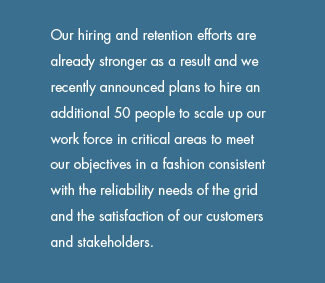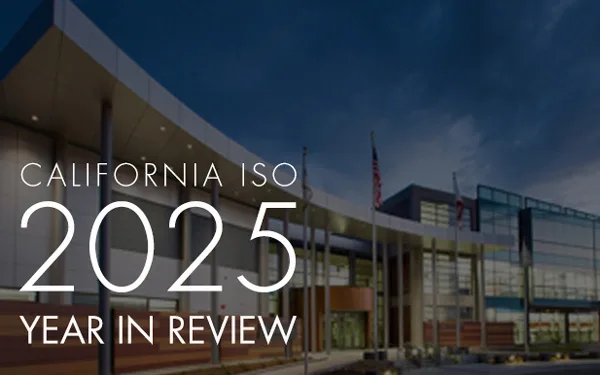Reflections on a collaborative and productive year


The past year was another fast-paced, productive time for all of us at the California Independent System Operator. I am deeply appreciative of everything we were able to achieve in 2022 working with our many partners in California and across the West.
Keeping the bulk power system reliable and operating smoothly is priority number one at the ISO. With a lot of help and collaborative planning for the summer, we kept the lights on throughout the historic September heat event despite record temperatures and unprecedented demand for electricity throughout much of the region.
The ISO’s report on the 10-day-long heat wave, which includes a detailed analysis of what went right and where we have committed to make some improvements, is a reflection of our commitment to transparency and providing important information to the public. I am proud of how we worked collectively to meet the moment with Governor Gavin Newsom’s office, California state agencies, neighboring states and balancing authorities, utilities and the public that stepped up to answer the calls to conserve in response to our Flex Alerts and the wireless alert from the Governor’s Office of Emergency Services.
Enhanced planning and collaboration

To make sure we are properly focused on the most pressing issues in an energy landscape that is changing rapidly, earlier in the year – following extensive outreach to our stakeholders and governing bodies – the ISO released its 2022-2026 Strategic Plan. The plan articulates the organization’s top critical strategic and tactical objectives, serving as the central organizing principle for the ISO and guiding our priorities and external efforts over the next five years. The plan also reframes the ISO’s vision, which is to “operate the world’s most reliable, cost-effective and environmentally sustainable power system.”
To match the ISO’s aspirations with its outcomes, we spent considerable time in 2022 collaborating with industry and our partners in state government to help ensure California continues onboarding the significant amounts of renewable resources and infrastructure needed to stay on track with decarbonization goals required under California Senate Bill 100.
A significant part of that effort is reflected in the ISO’s first-ever 20-year Transmission Outlook released in February. Done in tandem with our traditional annual transmission planning process, the Outlook is designed to help enable and accelerate the integration of renewables onto the grid, with a blueprint for how to help make that happen.

In drafting the Outlook, our infrastructure and operations planning team worked closely with the California Energy Commission (CEC), California Public Utilities Commission (CPUC) and a diverse group of stakeholders to begin delineating the long-term architecture of the California grid.
Having a clearer picture of transmission needs 20 years from now will similarly help inform decisions and investments needed about transmission upgrades today. The Outlook is also designed to better align power and transmission planning, resource procurement and the interconnection queuing processes that we improved through two rounds of enhancements in 2022.
As the result of this work and the growing consensus around the importance of a more nimble, proactive and coordinated system for meeting the state’s transmission needs, we expect the ISO’s 2022-23 transmission plan to be an extremely consequential and impactful one.
On this issue and others, the ISO has been working more effectively than ever with the CEC and CPUC, as each of us has very specific statutorily defined roles to play in making sure California has all the safe, clean and reliable energy it needs now and far into the future.
To be optimally coordinated in those efforts, we will soon sign a new Memorandum of Understanding developed in 2022 by the three organizations. The agreement will specifically delineate the steps each entity will take to mesh the CEC’s forecasting and assessment work done through its Integrated Energy Policy Report with the CPUC’s procurement and Integrated Resource Plan and the ISO’s long and medium-term transmission planning. This type of forward-looking planning and coordination is essential to meeting California’s energy policy goals reliably and efficiently.

Reliability and storage
Few actions have contributed to grid reliability as much as the record amounts of capacity already added to the system over the past several years, particularly new lithium-ion battery resources, under recent procurement authorizations approved by the CPUC and implemented by California load-serving entities.
We now have about 4,400 megawatts of battery storage available to the grid – resources that were vital last summer in meeting net peak demand, the hours when electricity use remains high as the sun sets and solar capacity declines. The ability to dispatch clean power from batteries charged during the day, when solar is abundant, has enhanced reliability and provided our grid operators greater flexibility.
More storage and other clean resources will be added over the next several years as we continue to work closely with the industry to refine market processes for storage integration, including the long-duration storage technology we know will be needed in the future.
To help tell this important story, the ISO released a video in March, From Idea to Reality - Battery Storage Comes of Age on the California Grid, that showcases some of the energy policies and actions that helped make storage such a dependable part of our resource fleet.

Another reliability-driven initiative is the multi-year effort we launched in 2022 to improve the ISO’s control center processes and tools. This project goes to the heart and soul of the ISO. It is essential that our grid operators have state-of-the-art tools to keep power flowing reliably and cost-effectively across the grid as demand for electricity grows, the market expands, and we continue the carbon-free transition.
Among other actions, our control center foundational improvement and modernization initiative includes tightening how we test sophisticated new software and strengthening our training programs as we integrate new technology into control center operations. By following through on these and other enhancements we have identified, our grid operations will achieve the “best in class” status the ISO aspires to.
An extended day-ahead market takes shape
Against this busy backdrop and dynamic energy landscape, we have seen a growing appreciation that no state can achieve its energy policy goals alone. We need to work together to keep delivering the power on which our people and economy depend. That is why we spent so much time in 2022 working with our peers and partners in California and across the region to design the rules and protocols needed to establish an extended day-ahead market (EDAM) that can better serve California and our partners across the West.
Our collective goal is to build on the success of the ISO’s Western Energy Imbalance Market (WEIM), which has enhanced reliability, reduced greenhouse gas emissions and achieved more than $3 billion in cumulative benefits for market participants since launching in 2014. This success also includes the transition to a joint authority governance model between the ISO Board of Governors and the WEIM Governing Body, which has been working well to enhance cooperation between the two entities, reflecting the interconnected nature of the markets. This evolution included the WEIM Governing Body hiring an independent market expert to further support effective decision-making under the joint authority model.
Throughout 2022, we worked closely with utilities, regulators and other stakeholders in California and the West to design a day-ahead market we believe will produce even more significant economic, reliability, and environmental benefits for participants and the states we serve.
The ISO released its final EDAM proposal on December 7, the same day that the stakeholder-driven WEIM Governance Review Committee published its proposed governance framework for EDAM. One day later, we were extremely pleased and encouraged when Portland-based PacifiCorp, one of the largest and most innovative utilities in the nation – it was also the first entity to join the WEIM eight years ago – announced it intends to be part of the EDAM when it goes live in 2024.

We look forward to additional EDAM commitments as we continue refining market design and governance in 2023. Our experience and the work we have done with colleagues throughout the region have convinced us that EDAM can be a major step toward a more coordinated and collaborative regional power grid. It can also be a game changer for California and neighboring states, especially when system conditions are stressed by extreme weather, as happened the past three summers.
Last August, in a rare unanimous, bi-partisan vote, the Legislature approved Assembly Concurrent Resolution 188 sponsored by Assembly Appropriations Committee Chair Chris Holden of Pasadena. The measure asked the ISO to “summarize recent relevant studies on the impacts of expanded regional electric grid cooperation on California and to identify key issues that will most effectively advance the state’s energy and environmental goals, including any available studies that reflect the impact of regionalization on transmission costs and reliability for California ratepayers.” We appreciate Chair Holden’s work on this issue and know it is likely to result in a renewed and constructive policy conversation in California and the West on this important topic in 2023.
Internal analysis and our changing workforce
With so much happening all at once on the energy front, we felt it was important to undertake some deep internal analysis in 2022 regarding organizational capacity. We followed through with a number of actions we believe better position the ISO to fulfill its obligations while continuing to attract and retain the skilled and engaged workforce needed to be successful.

With state, national, and global labor markets experiencing significant disruptions from the COVID pandemic – and after considerable deliberation, analysis, and consultation with our employees – we announced in May that the ISO was moving to a “personal choice flexible work policy.” The change allows a large portion of our employees to work remotely should they choose to. We are convinced the paradigm shift is a necessary strategic tool to achieve our goals, empower employees to do their best work, foster individual and collective wellbeing, maintain business continuity in the case of disruptive events, and support a diverse and inclusive work environment.
Our hiring and retention efforts are already stronger as a result and we recently announced plans to hire an additional 50 people to scale up our work force in critical areas to meet our objectives in a fashion consistent with the reliability needs of the grid and the satisfaction of our customers and stakeholders. This is a historic level of investment in human capital at the ISO. It is also essential to meet our strategic objectives and position the organization for long-term success. We have already started to bring some highly skilled new employees into the ISO and I am enthusiastic about the positive impact they will have on the work we do.
Another significant aspect of our internal analysis has been to closely examine our internal governance and decision-making model so we are working as efficiently and as thoughtfully as the times demand. We have been taking a number of steps to do a better job prioritizing, sequencing and allocating resources for the initiatives we embark on so our employees and customers experience the optimum results in the process. No organization can truly thrive without robust decision-making about how it uses its time and resources. We have committed to making important adjustments in this area to ensure ongoing excellence in all we do.
When I pause to reflect on everything we worked on over the past year, I continue to be inspired by our employees’ ability to manage all of our different obligations and initiatives. Along the way, I am happy to report that we also enjoyed some purely fun events like the ISO Fall Harvest Festival held for employees and their families in early November at our Folsom headquarters. More than 800 people attended the outdoor event, celebrating the season and the work we do with colleagues, families and friends.

A few days later, on November 9 and 10, we held our first biennial Stakeholder Symposium in four years. The event at the new SAFE Credit Union Convention Center in downtown Sacramento drew nearly 900 in-person participants and hundreds more virtually to hear some of the most prominent voices in the Western energy community share their views on key issues shaping our energy future. We also took a moment to honor our beloved colleague, Therese Hampton, who chaired the WEIM Governance Review Committee, and tragically passed away in September.
This is a dynamic and exciting time for energy policies and practices in the West. The growing collaborative spirit and an accelerated transition to renewable resources are cause for real encouragement even as we confront more frequent extreme weather and other risks associated with climate change. I have no doubt 2023 will be another productive year for all of us working through these issues. Because of everything we achieved collectively in 2022, I am optimistic that when we reflect back a year from now it will be with an even greater sense of appreciation for everything that can be done working collaboratively to better serve California and the broader West.
With deep gratitude for the support we get from the ISO’s governing entities, our partners in state government and customers, stakeholders and colleagues throughout the region, the California ISO wishes you all a wonderful, healthy holiday season and a Happy New Year.


